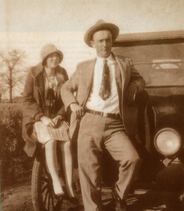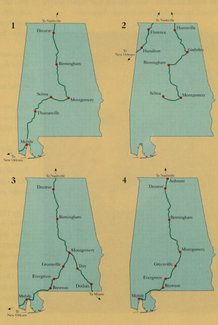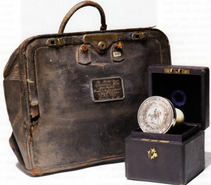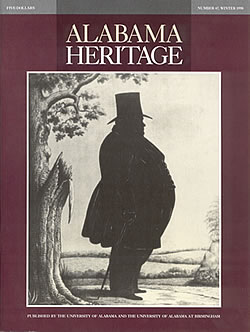|
On the cover: This silhouette of Alabama senator Dixon Hall Lewis was created by William Henry Brown. (Courtesy William Stanley Hoole Special Collections Library, University of Alabama)
|
FEATURE ABSTRACTS
 Delmus Willie Zorn with the love of his life, Flora O.Z. Dukes, c. 1931, in Henry County. D.W.'s chosen profession, moonshiner, was frowned upon by O.Z.'s family, but the couple wed nevertheless after a seven-year courtship. (Courtesy Steve Elliot.)
Delmus Willie Zorn with the love of his life, Flora O.Z. Dukes, c. 1931, in Henry County. D.W.'s chosen profession, moonshiner, was frowned upon by O.Z.'s family, but the couple wed nevertheless after a seven-year courtship. (Courtesy Steve Elliot.)
The Life and Times of D.W. Zorn (A Story That Is Mostly True)
By Steve Elliott
The life of Delmus Willie Zorn, "one of the best moonshiners to ever come out of Henry County [Alabama]" and Zorn’s moonshine business are profiled by author Steve Elliott, grandson of D.W. Zorn. Elliott describes the man who developed a thriving business in fine (if illegal) whiskey-distilling as "a wanderer, a good-timer, a lover of the soil on which he was born and raised." Although many moonshiners used the trade as a supplement to farming, D.W. Zorn and his cousin Whit maintained a full-time career in "hauling whiskey." The Zorns’ reputation for high production standards earned them customers all over south Alabama and Georgia, from farmers to bankers. They aged their whiskey for up to a month in wooden kegs with charred interiors. Said D.W. Zorn of the finished product, "You could drink it like water and it wouldn’t burn you. Brother, that was some good stuff!"
Additional Information
In addition to his grandfather, Elliott interviewed many other people from Henry County over a period of some twenty-five years in an effort to learn more about the era. Among those interviewed were: William W. Nordan, William Ralph Chambers, Needam Taylor "Bud" Zorn, Ruben Barnes, Louie Jones, Mary Martha Zorn Elliott, Eddie Hickland Hall, Frank Money, Sr., Ada Idelia Dukes Holland, and Voncile Zorn Rouse.
Additional information was obtained from the family Bible of Capt. Dennis H. Zorn; Zorn family files, Orangeburg, South Carolina, Archives; and Minutes of the New Prospect Primitive Baptist Church, Book 1, Brown's Crossroads, Henry County. Elliott also consulted the History of Henry County, Alabama, by Mrs. Marvin Scott (1961), Brief History of Mount Zion Colored Baptist Church, by Cornelious Stovall Davis (1984), and editions of the Wiregrass Farmer, Headland, and the Newville Advertiser, Newville.
The following article in the Encyclopedia of Alabama will also be of interest:
About the Author
A native of Haleburg, Alabama, Steve Elliott holds a B.S. in history education from Troy State University. He is a former Henry County educator, a former representative for the Herff Jones Yearbook Company, and the founding president of the Haleburg Historical Society. Presently he is working to restore the Mt. Zion Colored Baptist Church, c. 1871, in Haleburg. Inspired by a teacher, the late Christine Glover McGriff, Elliott has been researching the history of his family and the town of Haleburg since he was twelve. He and his grandfather, D. W. Zorn, spent many hours together retracing D. W.'s childhood and moonshining days.
By Steve Elliott
The life of Delmus Willie Zorn, "one of the best moonshiners to ever come out of Henry County [Alabama]" and Zorn’s moonshine business are profiled by author Steve Elliott, grandson of D.W. Zorn. Elliott describes the man who developed a thriving business in fine (if illegal) whiskey-distilling as "a wanderer, a good-timer, a lover of the soil on which he was born and raised." Although many moonshiners used the trade as a supplement to farming, D.W. Zorn and his cousin Whit maintained a full-time career in "hauling whiskey." The Zorns’ reputation for high production standards earned them customers all over south Alabama and Georgia, from farmers to bankers. They aged their whiskey for up to a month in wooden kegs with charred interiors. Said D.W. Zorn of the finished product, "You could drink it like water and it wouldn’t burn you. Brother, that was some good stuff!"
Additional Information
In addition to his grandfather, Elliott interviewed many other people from Henry County over a period of some twenty-five years in an effort to learn more about the era. Among those interviewed were: William W. Nordan, William Ralph Chambers, Needam Taylor "Bud" Zorn, Ruben Barnes, Louie Jones, Mary Martha Zorn Elliott, Eddie Hickland Hall, Frank Money, Sr., Ada Idelia Dukes Holland, and Voncile Zorn Rouse.
Additional information was obtained from the family Bible of Capt. Dennis H. Zorn; Zorn family files, Orangeburg, South Carolina, Archives; and Minutes of the New Prospect Primitive Baptist Church, Book 1, Brown's Crossroads, Henry County. Elliott also consulted the History of Henry County, Alabama, by Mrs. Marvin Scott (1961), Brief History of Mount Zion Colored Baptist Church, by Cornelious Stovall Davis (1984), and editions of the Wiregrass Farmer, Headland, and the Newville Advertiser, Newville.
The following article in the Encyclopedia of Alabama will also be of interest:
About the Author
A native of Haleburg, Alabama, Steve Elliott holds a B.S. in history education from Troy State University. He is a former Henry County educator, a former representative for the Herff Jones Yearbook Company, and the founding president of the Haleburg Historical Society. Presently he is working to restore the Mt. Zion Colored Baptist Church, c. 1871, in Haleburg. Inspired by a teacher, the late Christine Glover McGriff, Elliott has been researching the history of his family and the town of Haleburg since he was twelve. He and his grandfather, D. W. Zorn, spent many hours together retracing D. W.'s childhood and moonshining days.
 As Alabama's early highway system developed, various factions fought to have their preferred north-south route adopted. Shown here are: (1) Alma Rittenberry's proposed Jackson Highway, (2) the Huntsville-gadsden contingent's "Alabama Branch," (3) Rittenberry's response-the Bee Line Highway (with eastern and western branches), and the final version: U.S. Highway 31/State Highway 3. (Courtesy Alan Grady and the University of Alabama Cartographic Laboratory)
As Alabama's early highway system developed, various factions fought to have their preferred north-south route adopted. Shown here are: (1) Alma Rittenberry's proposed Jackson Highway, (2) the Huntsville-gadsden contingent's "Alabama Branch," (3) Rittenberry's response-the Bee Line Highway (with eastern and western branches), and the final version: U.S. Highway 31/State Highway 3. (Courtesy Alan Grady and the University of Alabama Cartographic Laboratory)
Aunt Babe, Uncle Simp, and the Origins of U.S. Highway 31
By Alan Grady
Since its beginnings in the early part of this century, the route designated U.S. Highway 31 has drastically changed the course of transportation and the mode of travel in Alabama. While it was William Simpson Keller, Alabama’s first chief highway engineer, who decided on the final route, it was pioneering Alabama feminist Alma Rittenberry who began the quest for a better north-south highway, one that would bring the North and South "into closer bonds of friendship and brotherly love." As the "Good Roads" movement grew in popularity, individual citizens and state officials realized the need for a unified north-south route from the Great Lakes to the Gulf. "Aunt Babe, Uncle Simp, and the Origins of U.S. Highway 31" tells the story of how two strong-minded figures contributed to the development of the highway in Alabama.
Additional Information:
Maude McLure Kelly - AL Women's Hall of Fame
For the history of the Alabama Highway Commission and its major rome decisions, the author recommends the Alabama Department of Transportation "Minutes of the Department," open to public inspection. Information on the Jackson Highway and the Bee Line Highway may he found in the Alabama Department of Archives and History's collection of Southern Good Roads.
About the Author
Alan Grady, the lead contract historian for NASA's Marshall Space Flight Center in Huntsville, holds a B.S. in political science from Jacksonville State University and an M.A. in history from the University of Alabama in Huntsville. He first "discovered" U.S. Highway 31 on his frequent trips to Birmingham and Montgomery while researching material for his first Alabama Heritage article, "When Good Men Do Nothing: The Murder of Albert Patterson," Winter 1996.
The author wishes to thank the following for their assistance with research for this article: Richard Weingroff of the Federal Highway Administration, Rosemary Johnson and Ron Pouncey of the Alabama Department of Transportation, Susan Bzdell of the Morgan County Archives, the staff of the Birmingham Public Library Archives, the staff of the Alabama Department of Archives and History, and the families of Alma Rittenberry and William Keller.
By Alan Grady
Since its beginnings in the early part of this century, the route designated U.S. Highway 31 has drastically changed the course of transportation and the mode of travel in Alabama. While it was William Simpson Keller, Alabama’s first chief highway engineer, who decided on the final route, it was pioneering Alabama feminist Alma Rittenberry who began the quest for a better north-south highway, one that would bring the North and South "into closer bonds of friendship and brotherly love." As the "Good Roads" movement grew in popularity, individual citizens and state officials realized the need for a unified north-south route from the Great Lakes to the Gulf. "Aunt Babe, Uncle Simp, and the Origins of U.S. Highway 31" tells the story of how two strong-minded figures contributed to the development of the highway in Alabama.
Additional Information:
Maude McLure Kelly - AL Women's Hall of Fame
For the history of the Alabama Highway Commission and its major rome decisions, the author recommends the Alabama Department of Transportation "Minutes of the Department," open to public inspection. Information on the Jackson Highway and the Bee Line Highway may he found in the Alabama Department of Archives and History's collection of Southern Good Roads.
About the Author
Alan Grady, the lead contract historian for NASA's Marshall Space Flight Center in Huntsville, holds a B.S. in political science from Jacksonville State University and an M.A. in history from the University of Alabama in Huntsville. He first "discovered" U.S. Highway 31 on his frequent trips to Birmingham and Montgomery while researching material for his first Alabama Heritage article, "When Good Men Do Nothing: The Murder of Albert Patterson," Winter 1996.
The author wishes to thank the following for their assistance with research for this article: Richard Weingroff of the Federal Highway Administration, Rosemary Johnson and Ron Pouncey of the Alabama Department of Transportation, Susan Bzdell of the Morgan County Archives, the staff of the Birmingham Public Library Archives, the staff of the Alabama Department of Archives and History, and the families of Alma Rittenberry and William Keller.
 The Great Seal of the Confederate States, made in England, was carried across the Atlantic in this box and leather satchel. The courier, Lt. Robert T. Chapman, was instructed to throw the seal into the sea in case of imminent capture by Union forces. (Courtesy The Museum of the Confederacy, Richmond, Virginia)
The Great Seal of the Confederate States, made in England, was carried across the Atlantic in this box and leather satchel. The courier, Lt. Robert T. Chapman, was instructed to throw the seal into the sea in case of imminent capture by Union forces. (Courtesy The Museum of the Confederacy, Richmond, Virginia)
Adventures With the Great Seal of the Confederacy
By Charles Grayson Summersell
Further Adventures With the Great Seal
By Guy R. Swanson
In July 1864, less than a year before the Civil War ended, a young lieutenant in the Confederate navy set sail from England with precious cargo: the Great Seal of the Confederacy, symbol of the Confederate States and of the president’s authority. He was under strict instructions not to let the seal fall into enemy hands, even to throw it overboard if necessary. The Great Seal reached Richmond safely, but when that city fell to federal troops in April 1865, the seal disappeared. For almost fifty years only a few people knew where it was—and they were sworn to silence. "Adventures with the Great Seal of the Confederacy" describes the creation, subsequent disappearance, and rediscovery of the Great Seal--a topic involving intrigue, suspense, and several prominent Southern politicians, among them Alabamian Clement Claiborne Clay. "Further Adventures with the Great Seal," by Guy Swanson, an expert on the seal, relates information recently uncovered about the seal’s use during the Civil War.
Additional Information
For additional information about the Great Seal of the Confederacy, consult: primary materials int eh Great Seal of hte Confederacy Collection, Eleanor S. Brockenbrough Library, The Museum of the Confederacy, Richmond, Virginia; "From the Museum's Collections: The Great Seal of the Confederacy," by Guy R. Swanson, in the summer 1987 issue of The Museum of the Confederacy Journal; and narratives by William A. Albaugh III in the January 1974 issue of North South Trader and John Hollister in the March 1982 issue of Civil War Times Illustrated.
The following articles in the Encyclopedia of Alabama will also be of interest:Multimedia:
About the Authors
Charles Grayson Summersell a native of Mobile, received his B.A. and M.A. from the University of Alabama and a Ph.D. from Vanderbilt University. He began teaching in the University of Alabama's Department of History in 1935 and served as chair from 1954 to 1970, retiring in 1978. Summersell was a supporter of historic preservation in Alabama and one of the founding members of the Alabama Historical Commission; his volume Alabama History for Schools (1957) became the history textbook for the state's high schools. His other books include Mobile: History of a Seaport Town (University of Alabama Press, 1949); The Cruise of CSS Sumter (Confederate Publishing Company, 1965); The Journal of George Townley Fullam: Boarding Officer of the Confederate Sea Raider Alabama (1973, University of Alabama Press, 1973); and his last work, CSS Alabama: Builder, Captain, and Plans (University of Alabama Press, 1985). Following his death in 1987, his widow, Frances S. Summersell, established a one-million-dollar Charles Grayson Summersell Endowed Chair in Southern History at the University of Alabama, in honor of her husband.
Guy Swanson received his B.A. from Michigan State University and his M.A. and M.L.S. from the University of Alabama. He was previously employed by The Museum of the Confederacy and the United Daughters of the Confederacy.
By Charles Grayson Summersell
Further Adventures With the Great Seal
By Guy R. Swanson
In July 1864, less than a year before the Civil War ended, a young lieutenant in the Confederate navy set sail from England with precious cargo: the Great Seal of the Confederacy, symbol of the Confederate States and of the president’s authority. He was under strict instructions not to let the seal fall into enemy hands, even to throw it overboard if necessary. The Great Seal reached Richmond safely, but when that city fell to federal troops in April 1865, the seal disappeared. For almost fifty years only a few people knew where it was—and they were sworn to silence. "Adventures with the Great Seal of the Confederacy" describes the creation, subsequent disappearance, and rediscovery of the Great Seal--a topic involving intrigue, suspense, and several prominent Southern politicians, among them Alabamian Clement Claiborne Clay. "Further Adventures with the Great Seal," by Guy Swanson, an expert on the seal, relates information recently uncovered about the seal’s use during the Civil War.
Additional Information
For additional information about the Great Seal of the Confederacy, consult: primary materials int eh Great Seal of hte Confederacy Collection, Eleanor S. Brockenbrough Library, The Museum of the Confederacy, Richmond, Virginia; "From the Museum's Collections: The Great Seal of the Confederacy," by Guy R. Swanson, in the summer 1987 issue of The Museum of the Confederacy Journal; and narratives by William A. Albaugh III in the January 1974 issue of North South Trader and John Hollister in the March 1982 issue of Civil War Times Illustrated.
The following articles in the Encyclopedia of Alabama will also be of interest:Multimedia:
About the Authors
Charles Grayson Summersell a native of Mobile, received his B.A. and M.A. from the University of Alabama and a Ph.D. from Vanderbilt University. He began teaching in the University of Alabama's Department of History in 1935 and served as chair from 1954 to 1970, retiring in 1978. Summersell was a supporter of historic preservation in Alabama and one of the founding members of the Alabama Historical Commission; his volume Alabama History for Schools (1957) became the history textbook for the state's high schools. His other books include Mobile: History of a Seaport Town (University of Alabama Press, 1949); The Cruise of CSS Sumter (Confederate Publishing Company, 1965); The Journal of George Townley Fullam: Boarding Officer of the Confederate Sea Raider Alabama (1973, University of Alabama Press, 1973); and his last work, CSS Alabama: Builder, Captain, and Plans (University of Alabama Press, 1985). Following his death in 1987, his widow, Frances S. Summersell, established a one-million-dollar Charles Grayson Summersell Endowed Chair in Southern History at the University of Alabama, in honor of her husband.
Guy Swanson received his B.A. from Michigan State University and his M.A. and M.L.S. from the University of Alabama. He was previously employed by The Museum of the Confederacy and the United Daughters of the Confederacy.
DEPARTMENT ABSTRACTS
Art in the South
Dixon Hall Lewis: An Alabama Silhouette
By Robert O. Mellown
The silhouette of Dixon Hall Lewis (1802-1848), a U.S. senator from Lowndes County, Alabama, was created by William Henry Brown, a native of Charleston. Brown is considered one of America's leading nineteenth-century profilists, and the portrait of Lewis is regarded as one of his best.
Additional Information
The following articles in the Encyclopedia of Alabama will also be of interest:
About the Author
Robert Mellown is a professor of art history at the University of Alabama.
Dixon Hall Lewis: An Alabama Silhouette
By Robert O. Mellown
The silhouette of Dixon Hall Lewis (1802-1848), a U.S. senator from Lowndes County, Alabama, was created by William Henry Brown, a native of Charleston. Brown is considered one of America's leading nineteenth-century profilists, and the portrait of Lewis is regarded as one of his best.
Additional Information
The following articles in the Encyclopedia of Alabama will also be of interest:
About the Author
Robert Mellown is a professor of art history at the University of Alabama.
The Nature Journal
The Siren's Song
By L.J. Davenport
Eel-like in shape, with slimy skin, bushy gills, tiny lidless eyes, and no hind limbs, sirens smack of hideous monsters sallying forth from antediluviann ooze. One of two Alabama species, Siren intermedia inhabits quiet, shallow, often turbid waters where vegetation abounds. L.J. Davenport examines the life of the Siren intermedia.
Additional Information
The following article in the Encyclopedia of Alabama will also be of interest:Multimedia:
About the Author
Larry Davenport is a professor of biology at Samford University, Birmingham.
The Siren's Song
By L.J. Davenport
Eel-like in shape, with slimy skin, bushy gills, tiny lidless eyes, and no hind limbs, sirens smack of hideous monsters sallying forth from antediluviann ooze. One of two Alabama species, Siren intermedia inhabits quiet, shallow, often turbid waters where vegetation abounds. L.J. Davenport examines the life of the Siren intermedia.
Additional Information
The following article in the Encyclopedia of Alabama will also be of interest:Multimedia:
About the Author
Larry Davenport is a professor of biology at Samford University, Birmingham.
